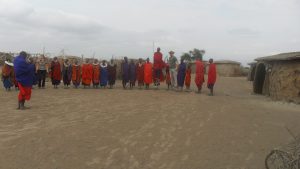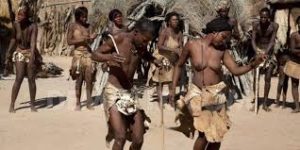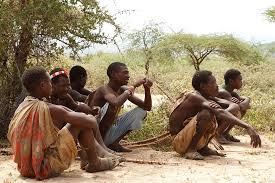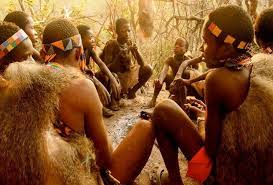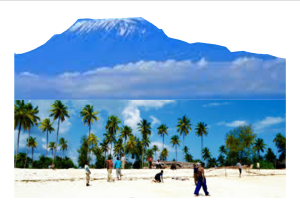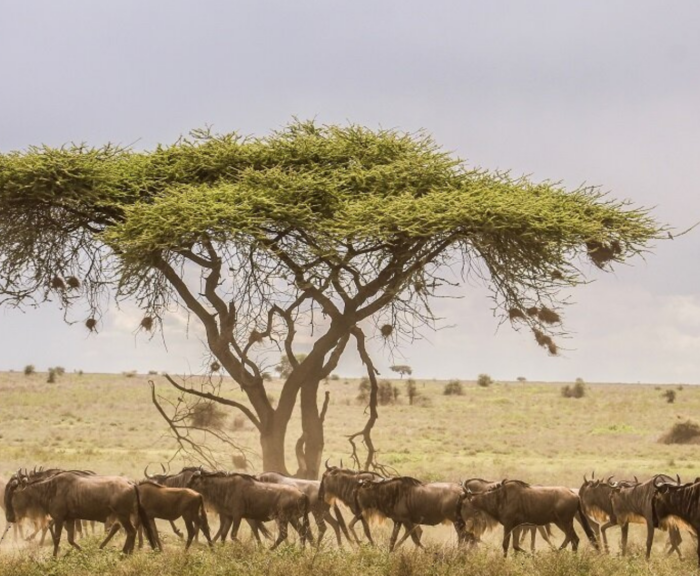Lake Natron, with its striking red hues and high alkalinity, is a breeding ground for millions of lesser flamingos. The lake’s harsh environment and unique colors attract visitors, especially for birdwatching during the flamingo breeding season. The nearby Engare Sero Waterfalls add to the surreal landscape.
Lake Eyasi, a shallow soda lake, is remote and culturally rich, home to the Hadzabe and Datoga tribes. Known for its birdlife and salt flats, this lake is ideal for birdwatching and learning about the traditional lifestyles of the hunter-gatherer Hadzabe and pastoral Datoga.
Lake Rukwa, located in the Rukwa Valley, is a quiet escape surrounded by wilderness. This saline lake supports various birds, hippos, and crocodiles, making it ideal for wildlife viewing. Its dynamic landscape changes with the seasons, attracting nature lovers seeking solitude.
Lake Duluti, a small crater lake near Arusha, is surrounded by dense forests and is perfect for canoeing and bird watching. Its calm, scenic setting makes it a peaceful retreat for those looking to enjoy nature close to the city.
These lakes showcase Tanzania’s beauty, from the vibrant life at Lake Victoria to the peaceful shores of Lake Duluti.
National Parks and Other Monuments in Tanzania

Tanzania is home to stunning national parks and historic sites, presenting diverse landscapes and rich wildlife across 22 protected areas. Here’s a look at some of Tanzania’s top parks and monuments.
Serengeti National Park and Ngorongoro Conservation Area
Serengeti National Park is a world-renowned safari destination, especially known for the Great Migration and high predator populations. It’s ideal for spotting lions, cheetahs, and wildebeest herds, with unique experiences like hot-air balloon safaris.
The Ngorongoro Conservation Area, home to the Ngorongoro Crater, is the largest volcanic caldera in the world and a UNESCO World Heritage site. It’s a prime location for observing the Big Five and provides one of Africa’s densest wildlife viewing areas.
Olduvai Gorge and Kilimanjaro National Park
Olduvai Gorge is one of the world’s most important archaeological sites, offering a glimpse into early human history. Often called the “Cradle of Mankind,” this site has yielded ancient fossils and tools that give insights into human evolution.
Kilimanjaro National Park encompasses Mount Kilimanjaro, Africa’s tallest peak, and attracts trekkers from around the world. The park supports diverse ecosystems, making it an excellent destination for nature and adventure lovers.
- Tarangire National Park: Known for its large elephant herds and unique baobab trees, Tarangire also offers walking safaris along the Tarangire River.
- Lake Manyara National Park: Famed for tree-climbing lions and birdwatching, Lake Manyara has lush scenery with views of the Great Rift Valley.
- Arusha National Park: This park, ideal for hiking, features Mount Meru and diverse landscapes, from montane forests to open grasslands.
Monuments and Historical Sites
- Stone Town, Zanzibar: A UNESCO World Heritage site, Stone Town is rich in history with landmarks like the House of Wonders, Old Fort, and Sultan’s Palace, reflecting a blend of African, Arab, and European influences.
- Kilwa Kisiwani: This ancient Swahili port was once a vital trading hub and is now a UNESCO site, with ruins of mosques, fortresses, and tombs from the 13th century.
- Bagamoyo: A former major trading port, Bagamoyo holds historical significance with structures like the Old Boma and German Fort, offering insights into Tanzania’s colonial past.
These parks and monuments capture Tanzania’s astonishing natural landscapes and rich historical heritage, making it an essential destination for both nature lovers and cultural explorers.
Cuisines of Tanzania: A Flavorful Journey

Tanzanian cuisine, with its rich mix of Bantu, Arab, and Indian influences, delivers a variety of flavors perfect for both meat-eaters and plant-based travelers. Here’s a look at some of the top dishes from Tanzania:
- Ugali: Ugali is Tanzania’s national staple, a dough-like porridge made from maize flour, cassava, or millet. It’s often eaten with the hands and served with vegetable stews, beans, or curries, making it an ideal, versatile base for plant-based meals.
- Pilau: This fragrant rice dish, cooked with spices like cumin and cardamom, is popular at gatherings and special occasions. It can easily be made vegan with vegetables or beans as the main accompaniment, highlighting Tanzania’s love for rich, spiced flavors.
- Wali wa Nazi (Coconut Rice): Coconut rice is a coastal favorite, cooked with coconut milk for a creamy flavor. It pairs well with vegetable curries and is a must-try for vegans and vegetarians exploring Tanzania’s coastal regions.
- Zanzibar Mix (Urojo): This tangy, spicy soup combines chickpeas, potatoes, and crispy fritters, often topped with chutney and lime. It’s a filling, naturally vegan street food available throughout Zanzibar.
- Fried Cassava and Roasted Corn: Both of these snacks are widely available from street vendors. Fried cassava, served with salt or chili powder, and roasted corn, charred over an open flame, are quick, vegan-friendly options for travelers on the go.
- Zanzibar Pizza: A unique street food resembling a stuffed pancake, Zanzibar Pizza offers a variety of fillings. Vegetarians can enjoy versions filled with vegetables, making it a delicious and satisfying option.
With its wide variety of dishes and flavors, Tanzania is a welcoming destination for vegetarian and vegan travelers. From staple foods like Ugali and Wali na Maharage (rice and beans) to street foods like Zanzibar Mix, plant-based travelers can enjoy the richness of Tanzanian cuisine with ease and authenticity.
Tanzania is home to over 120 unique tribes, each with distinct traditions and customs that contribute to the country’s rich cultural diversity. Here are a few prominent tribes:
- Maasai: Known internationally for their vibrant attire, customs, and warrior culture, they are pastoralists living near the African Great Lakes, speaking the Maa language and often Swahili and English.
- Hadzabe: One of the last hunter-gatherer tribes, the Hadzabe live near Lake Eyasi. With only a few hundred practicing traditional lifestyles, they face challenges from encroaching pastoralists.
- Datoga: Once spread widely across northern Tanzania, the Datoga are now mainly around Lakes Manyara and Eyasi. Known for their agro-pastoral lifestyle, they are skilled farmers and craftsmen, easily recognizable by their unique circular facial tattoos.
- Iraqw: A Cushitic-speaking people from the Arusha and Manyara regions, the Iraqw practice intensive agriculture and tend cattle. Known for building underground tunnels in their homesteads as a defense mechanism, they traditionally conflicted with the Maasai.
These tribes reflect the diversity of Tanzania’s heritage, offering visitors a chance to experience varied lifestyles, languages, and traditions across the country.
On your safari to Tanzania, you can have experiences that range from magnificent wildlife encounters to immersive cultural tours. Here are a few standout experiences to consider:
- Serengeti Safari: Watch the awe-inspiring Great Migration as wildebeests and zebras roam across the plains.
- Ngorongoro Crater Safari: Experience the Big Five in this remarkable UNESCO World Heritage site, a hub of rich wildlife.
- Serengeti Balloon Ride: Float over the vast Serengeti at sunrise for panoramic views and sightings of animals below.
- Mount Meru Climb: Take a scenic trek in Arusha National Park, with forested trails, wildlife encounters, and vistas of Kilimanjaro.
- Canoeing on Momella Lakes: Paddle along these colorful, algae-rich lakes to see flamingos, giraffes, and other local wildlife.
- Arusha Walking Safari: Explore lush paths and spot giraffes, buffaloes, and vibrant bird species on foot.
- Kilimanjaro Hike: Conquer Africa’s highest peak on one of seven trekking routes through diverse landscapes and wildlife zones.
- West Kilimanjaro Maasai Visit: Join a Maasai-guided walking safari, tour a traditional boma, and engage in local conservation efforts.
- Lake Eyasi Cultural Tour: Meet the Hadza and Datoga tribes, join a hunt, and learn traditional skills in this immersive experience.
- Lake Natron Birdwatching: Marvel at flamingoes in their natural breeding grounds, with stunning sunrise and sunset views.
- Ancient Footprints at Lake Natron: See some of Africa’s oldest hominid footprints preserved near the lake’s edge.
- Ngare Sero Waterfalls Hike: Follow scenic trails to this beautiful waterfall set among volcanic rock and lush greenery.
- Ol Doinyo Lengai Climb: Scale the “Mountain of God” under the stars for unforgettable sunrise views across the plains.
- Zanzibar Water Sports: Discover coral reefs and colorful marine life through diving, snorkeling, and kayaking in clear waters.
- Whale Shark Snorkeling on Mafia Island: Snorkel with whale sharks for a close-up experience of these gentle giants.
- Lake Manyara Safari: See tree-climbing lions, elephants, and over 300 bird species in a landscape of lakes and forests.
- Chimpanzee Trekking in Gombe: Take a guided hike to observe chimpanzees and other primates in their forest home.
- Serengeti Balloon Safari: Soar above the iconic plains at sunrise, taking in the sweeping landscape and wildlife below.
From thrilling safaris and mountain treks to cultural encounters and water adventures, Tanzania offers an unforgettable journey for every traveler.
Social Activities in Tanzania
ATA Safaris offers unique ways for visitors to connect with local communities and support conservation efforts.
Village Visits and Community-Based Tourism
Village visits provide an authentic glimpse into Tanzanian life. Travelers can engage with artisans, learn traditional crafts, and experience the cultural practices of tribes like the Maasai. Community-based tourism helps generate income for these communities, making tourism a sustainable source of support.
Supporting Conservation and Sustainable Tourism
For travelers wanting to contribute to conservation, volunteer programs offer opportunities to support wildlife and ecosystem preservation. To make a further impact, ask your tour operator about reputable organizations you can support, such as:
- Honey guide Foundation: Works with communities to conserve resources and wildlife.
- PAMS Foundation: Protects endangered species and natural habitats.
- Serengeti De-Snaring Project: Removes snares to protect wildlife in the Serengeti.
Donating to these organizations directly supports Tanzania’s conservation efforts, helping to protect its unique wildlife and ecosystems.
Plan Your Trip to Tanzania
Tanzania is a truly captivating destination for nature enthusiasts, offering endless possibilities, from breathtaking safaris to peaceful beaches, vibrant traditions, and thrilling adventures. Every corner of Tanzania invites you to connect with nature in its purest form. If you’re seeking unforgettable experiences in an extraordinary setting, it’s time to add Tanzania to your travel bucket list.
FAQs for Visiting Tanzania
1. What is the best month to visit Tanzania?
The best time to visit Tanzania is during the dry season, from July to October, which coincides with the Great Wildebeest Migration. The country has a tropical climate with coastal areas that are hot and humid, while the low-lying parks are cooler and dryer.
2. Is it safe to travel to Tanzania right now?
Exercise a high degree of caution in Tanzania due to the risks of violent crime and terrorism. Travelers should remain alert, especially in certain areas. Review safety advisories before visiting.
3. How much is a decent meal in Tanzania?
On average, daily food expenses in Tanzania are around $13 (30,500 TZS). Local diners and street food options are inexpensive, while a three-course meal at a mid-range restaurant typically costs about $21 (50,000 TZS).
4. What is a kanga in Tanzania?
A Kanga is a traditional Tanzanian textile featuring a patterned border (pindo), a central motif (mji), and a Swahili proverb or phrase (jina).
5. What do Swahili people wear?
Swahili men traditionally wear long robes with a rounded, embroidered hat. Women wear long dresses or draped clothes and cover their heads with a cloth. Clothing often features bright colors and stripes.
6. What is Tanzania most famous for?
Tanzania is widely known for Mount Kilimanjaro, Africa’s highest mountain. The country is also renowned for its diverse ecosystems, making it a top destination for hikers and nature enthusiasts.
7. Why is Tanzania so special?
Tanzania is celebrated for its stunning landscapes and abundant wildlife, including attractions like Mount Kilimanjaro, Serengeti National Park, and the Ngorongoro Crater. Its rich cultural heritage and beautiful beaches, especially on Zanzibar Island, add to its allure.
8. What is an example of ecotourism in Tanzania?
The Mount Kilimanjaro forest is a popular ecotourism destination known for its conservation efforts. Activities include trekking, wildlife tours, bird watching, adventure hiking, and mountain biking.
9. What is Tanzania most famous for?
Tanzania is widely known for Mount Kilimanjaro, Africa’s highest mountain. The country is also renowned for its diverse ecosystems, making it a top destination for hikers and nature enthusiasts.
Tanzania is celebrated for its stunning landscapes and abundant wildlife, including attractions like Mount Kilimanjaro, Serengeti National Park, and the Ngorongoro Crater. Its rich cultural heritage and beautiful beaches, especially on Zanzibar Island, add to its allure.
Source link

